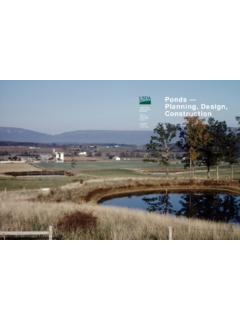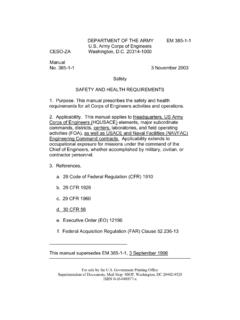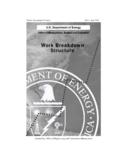Transcription of EXCAVATOR HANDBOOK
1 PIPELINE safety BUREAUEXCAVATORHANDBOOKE xcavator Manual 14/16/13 9:44 AMExcavator Manual 24/16/13 9:44 AM1 NOTICE OF DISCLAIMER THIS GUIDE IS FOR INFORMATIONAL PURPOSES ONLY. INFORMATION IS INCLUDED FOR YOUR CON-VENIENCE. IT IS YOUR RESPONSIBILITY TO KNOW AND COMPLY WITH THE PROVISIONS OF NEW MEX-ICO LAW, THE PUBLIC REGULATION COMMISSION S RULES AND FEDERAL REGULATIONS IN THEIR EN-TIRETY, INCLUDING ANY MODIFICATIONS MADE SUBSEQUENT TO THIS WRITING. SOME OR ALL OF THE METHODS OR PROCEDURES DESCRIBED MAY NOT BE APPLICABLE OR APPROPRIATE FOR USE BY YOUR ORGANIZATION. IN ANY EVENT AND RE-GARDLESS OF ERRORS, INACCURACIES, OR OMIS-SIONS IN THIS GUIDE, NEW MEXICO 811, AND THE STATE OF NEW MEXICO ASSUME NO LIABILITY OF ANY KIND ARISING OUT OF ANY USE OR RELIANCE UPON THIS INFORMATION BY YOU OR ANYONE IN YOUR ORGANIZATION, INCLUDING, BUT NOT LIM-ITED TO, ANY LIABILITY FOR ANY INJURY TO PER-SONS OR ANY DAMAGE TO PROPERTY.
2 Published in cooperation by the New Mexico Public Regulation Commission, Department of Transportation Pipeline safety Bureau and New Mexico One Call, Inc. DBA New Mexico 811 2004, 2007, 2009, 2012 Pipeline safety Bureau NM Public Regulation Commission Box 1269 Santa Fe, NM 87504-1269 New Mexico 811 1021 Eubank Blvd NE Albuquerque, NM 87112 EXCAVATOR Manual 14/16/13 9:44 AM2 Table of Contents PREFACE ..4 INTRODUCTION ..5 Who we are ..5 PREPARING TO MAKE A LOCATE REQUEST ..6 Preparing plans for excavation ..6 Planning your excavation ..7 Collecting information for the locate request ..7 MAKING THE LOCATE to contact NM811 ..10 Contacting NM811 ..10 The Standard Locate Request ..12 When you call NM811 ..12 Legal matters ..14 WHAT HAPPENS AFTER YOU CALL ..14 After you contact NM811 ..14 Locating all underground facilities ..15 Clears.
3 15 Barricading ..16 DIG SAFELY ..16 Dig safely around facilities ..16 Preserve line location and markings ..17 The 18-inch rule ..18 Expose the underground facilities ..19 Backfill in a careful manner ..19 Call for relocates ..19 Precautions when working around gas pipelines ..20 Typical Pipeline Markers ..20 Facilities not marked ..22 EXCAVATOR Manual 24/16/13 9:44 AM3If you damage an underground facility ..22 What to do if you damage a gas ..24 OTHER TYPES OF ONE-CALL TICKETS ..25 Design Conference ..25 Design Locate ..26 Bid Conference ..26 Bid Locate ..26 Wide Area Locate Process ..26 Road maintenance ..28 RESPONSIBILITIES OF FACILITY OWNERS ..29 State law requirements for facility owners or operators ..29 Marking the facilities ..29 What happens if your facilities are damaged? ..30 Communication Regarding Locate ..31 Positive Response.
4 31 Approved colors and marking standards ..32 Moving or obliterating markings ..32 Reporting damages ..33 Relocates ..33 Emergency Locate Requests ..34 Guidelines for determining an emergency ..35 APPENDIx A -THE LAW ..36 APPENDIx B -THE RULES ..52 APPENDIx C - MARKING GUIDELINES ..109 APPENDIx D - WHITE LINING MARKING GUIDELINES ..115 APPENDIx E - NM s INCORPORATED CITIES, TOWNS, & VILLAGES ..120 EXCAVATOR Manual 34/16/13 9:44 AM4 PREFACE Excavation is a regulated activity in New Mexico. The Public Regulation Commission, Pipeline safety Bureau has statutory authority to administer New Mexico s Excavation Law Chap-ter 62, Article 14 NMSA 1978, including the assessment of fines for violations of the excava -tion law. This publication has been prepared for New Mexico s excavators as a reference guide for interacting with New Mexico 811 (NM811).
5 We recommend you give a copy of this guide to all employees who regularly contact NM811. Familiarity with its contents is essential for successful communication between the NM811 operator and the caller. We suggest you keep this guide on hand for future reference when questions or problems arise. We do not have a copyright on the material in this guide. We encourage you to copy part or all of it for fellow employees. Additional copies of this HANDBOOK are available in our web store at NOTE: The contents of this guide are subject to change without Manual 44/16/13 9:44 AM5 INTRODUCTION Who we are New Mexico One Call, Inc. DBA New Mexico 811 (NM811) is a statewide one-call notification center that was formed in 1990. Our purpose is to provide damage prevention resources by offering excavators and the public the ability to inform multiple underground facility owners of intended digs via a single telephone call to 811.
6 All underground facility owners are required by New Mexico state law to belong to a one-call notification system. Municipalities, pipelines, gas distribution, telecommunications, water, sewer, electric companies and others have un-derground facilities everywhere in New Mexico. Striking any one of these lines can cause ser-vice interruptions, injury and, potentially death! New Mexico state law requires everyone in-volved in any excavation to provide at least two working days notice to owners of underground facilities. This notification is accomplished by calling the one-call center at least two working days prior to beginning your excavation. The facility owners are then required to mark the horizontal locations of their underground lines within the two working days. EXCAVATOR Manual 54/16/13 9:44 AM6 PREPARING TO MAKE A LOCATE REQUEST Preparing plans for excavation New Mexico excavation law requires a person who prepares plans for excavation to provide certain information on the plans for the person who is doing the actual digging.
7 Plans, in a broad sense, include engineering construction documents (plans/specifications), work orders, maintenance orders, or any other format that provides instructions to the person digging. The requirements include determining the location of existing underground facilities, planning the excavation to avoid or minimize the interference with the existing facilities, provide support for existing facilities, and provide for se-lect backfill when necessary to prevent damage to existing facilities. The design or bid locate process is the method(s) used by the preparer of the plans to gather the information regarding the facilities, which must be included in the plans, prior to excavation. A preparer shall select either a design or bid locate request and it may be either a conference or physical locate request for obtaining information on the location of underground facilities.
8 However, the preparer may not switch methods once having made a choice. For an explanation of the design or bid tickets, please see the section of this HANDBOOK titled Other Types of One-Call Tickets. EXCAVATOR Manual 64/16/13 9:44 AM7 Planning your excavation New Mexico excavation law requires exca-vators to plan every excavation to minimize in-terference and prevent damage to underground facility lines in or near the excavation area. Locate requests should only include the amount of work that can be reasonably completed in 10 working days. Excavators are required by law, with limited exceptions, and it is an industry practice, to mark the excavation site in white before re-questing a locate. You can help facility owners identify conflicts by marking your excavation site with white paint, flags, stakes, whiskers or other appropriate white markings.
9 See Appendix D for NM White-lining Marking information for the locate request New Mexico s excavation law requires excavators to provide certain information to the one-call center. If you do not supply the neces-sary information, your request may be delayed or denied until the necessary information is pro-vided. As you plan for the request, be prepared to provide the following information: 1. EXCAVATOR s name (company), a contact person (first & last name), contact s day- time phone number, mailing address or a New Mexico 811 EXCAVATOR s ID Alternate contact information and daytime phone Manual 74/16/13 9:44 AM83. A brief description and purpose for the type of work to be done. For example: Repairing sewer line, or New electric service, or Installing new signs. 4. The name of the person or company for whom the work is being done.
10 5. Whether or not the excavation site is pre-marked in white. If it required by law that the dig site be marked in white, you must provide this information. If excava -tion location meets the exception criteria described in the law, the EXCAVATOR must provide clear and adequate identification of the actual dig site. Having the site marked in white using paint or flags or stakes etc. can make the spotting instructions in number 8 below easier to describe. It will also make it easier for the spotter to locate your dig site. 6. An accurate physical description of the location and size of the excavation loca-tion. For example: a street address, or GPS coordinates (with degrees in decimal format), or TRSQ legals are all good loca-tion descriptions. Reference to a plat of a subdivision is not a sufficient description. The one-call operator will also ask for the nearest cross streets.





